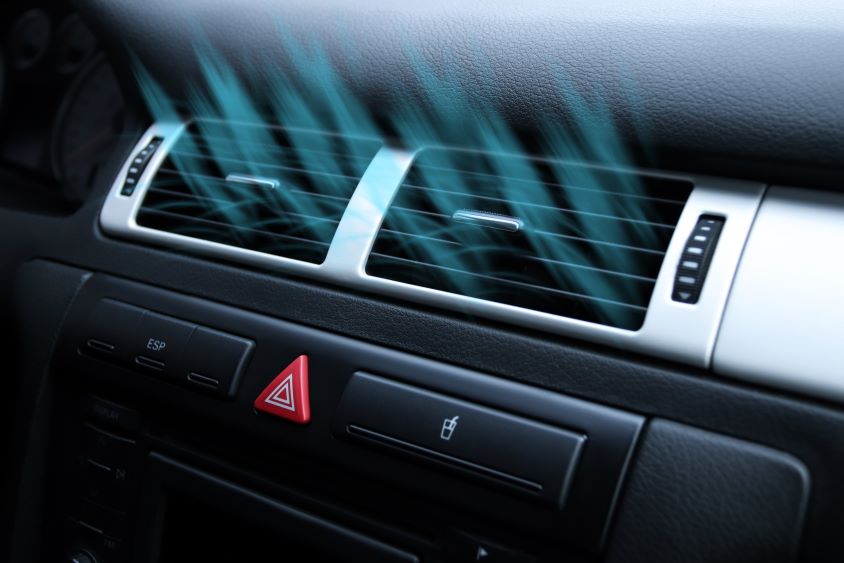When you’re behind the wheel on a hot day and need to cool down, it’s a common question: Should you turn on the air conditioning or just close the window?
Granted, it’s not the most crucial decision you’ll ever have to make regarding your car, but it’s always worth being fully informed so you can make the right call to boost fuel efficiency and maintain the health of your vehicle.
Benefits of using AC throughout the year
There are some significant benefits to using your air-con regularly over the year, as consistent use reduces the risk of the system seizing up and stops circulation from deteriorating.
Refrigerant and oil are required for your car’s A/C to work, so it’s a good idea to turn it on regularly to keep the liquid flowing and the system’s components lubricated.
During the winter, turning on the A/C to generate warm air is a good way to clear misty windows. The air from the vents is dry and acts as a dehumidifier.
How does car AC work?
A car’s air conditioning (AC) system cools the air inside the cabin by circulating refrigerant.
When the AC is turned on, the compressor, powered by the engine, compresses the refrigerant gas and sends it to the condenser. The condenser, usually located at the front of the car, cools the refrigerant by releasing heat and turning it from a gas into a high-pressure liquid.
This liquid refrigerant then travels through a series of pipes to the expansion valve or orifice tube, which expands rapidly and cools as it turns into a low-pressure liquid-gas mixture.
The refrigerant then flows through the evaporator inside the cabin, absorbing heat from the air. As the refrigerant evaporates, it cools the air inside the cabin, which is blown out through the vents by the blower fan. The refrigerant, now a warm gas, returns to the compressor to repeat the cycle.
This continuous process removes heat from the cabin, providing cold air and keeping the car’s interior comfortable during hot weather.
This guide shows how you can effectively manage your fleet to ensure everything runs smoothly.
Does car AC use fuel or battery?
Car air conditioning (AC) systems typically use the engine’s power, which relies on fuel rather than the car’s battery.
The engine drives the AC through a belt connected to the compressor, which is the component responsible for circulating the refrigerant. When the AC is turned on, the engine uses extra fuel to power the compressor. Running the AC can reduce fuel efficiency since the motor works harder.
However, in electric vehicles (EVs), the AC system runs off the battery, as there is no traditional internal combustion engine. The energy needed to power the AC is drawn from the vehicle’s electric battery, which can reduce the driving range when the AC is used extensively.
Should I have the window open?
When driving in hot weather, your first thought might be to open the windows. However, if the air conditioner runs simultaneously, opening the windows could make it harder to cool the car down.
Keeping the A/C on and the windows open isn’t particularly economical. Running the air conditioner puts additional strain on the engine, which consumes fuel. Still, an open window eliminates this effect by allowing cool air to escape and letting warm air in from the outside.
A handy rule of thumb is that keeping the windows closed will make the air conditioner more effective if it’s hotter and more humid outside the car than inside.
Read here about how efficient driving can reduce fuel costs.
Fuel efficiency whilst running the A/C or opening car windows
Fuel efficiency is another factor when switching the A/C or opening the window.
Both options impact your fuel consumption in some way. Opening windows means more drag on the car, slows it down and means the engine has to work harder and use more fuel. Air-con also places a demand on the engine and increases your fuel consumption.
In 2004, General Motors conducted several surveys to determine which option was more fuel-efficient. Keeping the windows down and the air conditioner off is probably more economical.
In really hot weather, however, you might not get the same cooling benefits from outside air as you do from your car’s A/C system.
Air-con needs to be checked and monitored like all vehicle components to keep it healthy. Getting the system re-gassed is often the best way to improve performance.
Regular servicing and maintenance ensures your car is always safe, comfortable and reliable. MyService.Expert from Fuel Card Services makes it easy to look after your car with access to thousands of garages all over the UK.
Find out more information in our guide about MyService.Expert here.
How to fix car AC not blowing cold air
If your car’s AC is not blowing cold air, multiple potential causes exist.
Check AC setting
Start by checking the AC settings to ensure the system is turned on, the fan speed is set appropriately, and the mode is correctly set to “cool.” A clogged air filter can restrict airflow, so check and replace it if needed.
AC low refrigerant levels and AC leaks
Another common cause of warm air is low refrigerant levels, which prevent the AC system from cooling properly. If the refrigerant is low, you can use a recharge kit, or you may need to have a professional inspect the system for leaks. Leaks in the refrigerant system can also cause cooling issues, and if you suspect this, a mechanic will need to perform a detailed inspection.
Malfunctioning AC compressor
A malfunctioning compressor can be another culprit, as it circulates refrigerant through the system; listen for unusual noises, and if the compressor is faulty, it may require replacement. Additionally, a dirty or blocked condenser can prevent proper cooling, so make sure it’s clean and debris-free.
AC blower fan
If the blower fan is not functioning correctly, this can also affect the airflow, and you may need to replace the motor or fan relay. Remember to check the AC fuse and relay, as a blown fuse can prevent the system from working.
AC control valve
Lastly, if the temperature control valve is malfunctioning, it might cause warm air to blow even when the system is on. If you’ve tried these steps and the issue persists, taking your car to a professional mechanic for further inspection and repairs is a good idea.
How much to fix AC in a car in the UK
The cost of fixing a car’s AC in the UK can vary depending on the specific issue and the make and model of the vehicle.
For simple problems, like recharging the refrigerant, you can expect to pay between £50 and £150. However, the costs can rise significantly if the system leaks or a component, such as a compressor or condenser, increases significantly.
Replacing a compressor, including parts and labour, can cost between £400 and £700, while replacing a condenser may cost between £250 and £500.
If the issue concerns electrical components or a faulty blower motor, you might incur costs between £150 and £400.
Remember that labour costs can also vary based on location, with rates typically ranging from £50 to £100 per hour.
How to cool car without AC & opening windows: other cooling methods
Cooling a car without air conditioning can be challenging, but there are other methods you can try to stay comfortable on hot days.
Another option is to use the vents: point the airflow towards your body or use the fan at a higher speed to encourage air circulation. If your car has a sunroof, opening it slightly can help create airflow and release heat.
To keep the interior cooler in advance, park in the shade whenever possible or use a windshield sunshade to block sunlight from entering through the front window.
Another option is to cover the seats with a light-coloured towel or cloth, as dark seats can absorb more heat.
If your car gets extremely hot in the sun, you can also place a small portable fan inside the vehicle.
For extra comfort, cool down your steering wheel and seats with a damp cloth or keep a spray bottle of water handy to mist yourself occasionally.
For longer-term solutions, consider installing aftermarket cooling options, such as portable fans or sunshades, designed to reduce the heat inside your car.
Learn our 7 top tips for driving in a heatwave today.
Ensure your AC is in top condition with Fuel Card Services
MyService.Expert offers a comprehensive and efficient fleet vehicle servicing, maintenance, and repairs solution.
The integrated system ensures cost clarity, streamlined billing, and better control over vehicle maintenance. Get your free quote now and experience the convenience and savings of MyService.Expert for your fleet.





